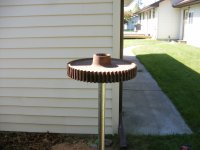bp fick
Super Member
Update:
Since I've driven 12' already, from now on, I'll drive shorter, 4' pieces of pipe.
More pieces means more drive couplings at $10 a crack, but oh well. Teflon on each connection, at least I am doing so.
That home made driven has been a godsend. You do have to stop and constantly re-tighten the couplings as the whacking tends to shock them into a loose state, which is a no no on the threads, of course.
When it comes time to hook up the pump, I may be asking some questions and some advice. So, all you jet well pump gurus, you may need to help me out on a few things.
Since I've driven 12' already, from now on, I'll drive shorter, 4' pieces of pipe.
More pieces means more drive couplings at $10 a crack, but oh well. Teflon on each connection, at least I am doing so.
That home made driven has been a godsend. You do have to stop and constantly re-tighten the couplings as the whacking tends to shock them into a loose state, which is a no no on the threads, of course.
When it comes time to hook up the pump, I may be asking some questions and some advice. So, all you jet well pump gurus, you may need to help me out on a few things.



